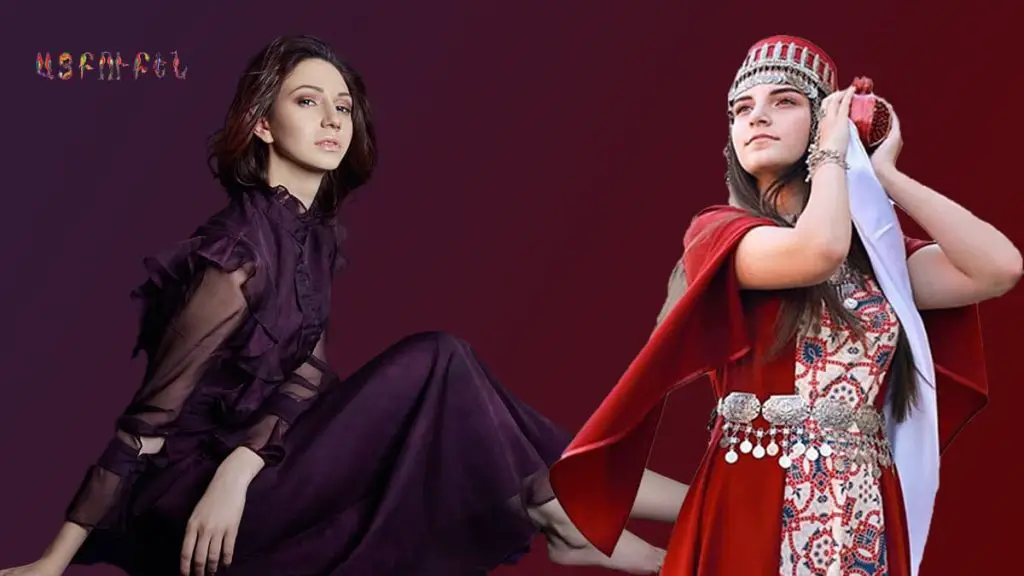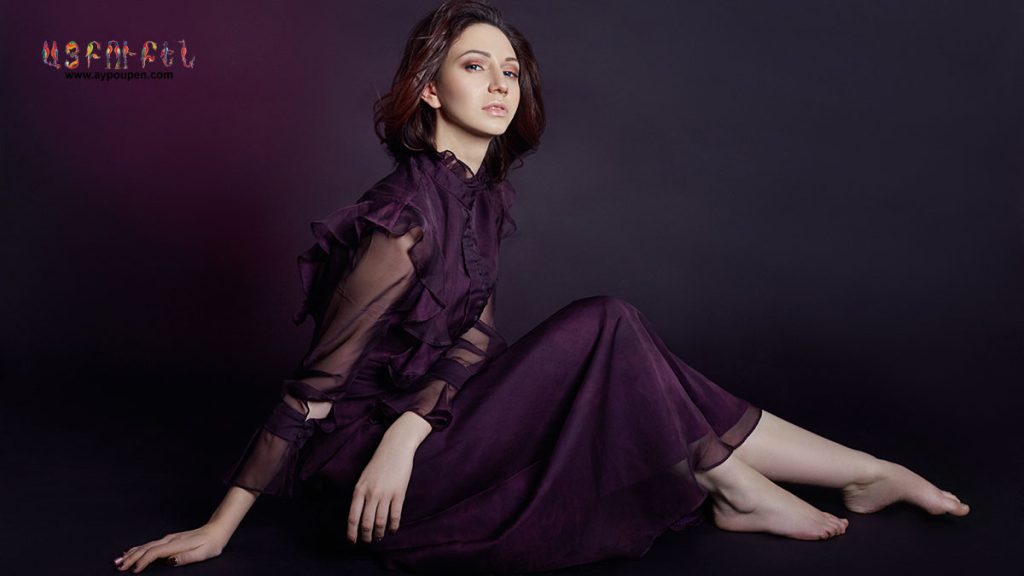Armenian Traditional Clothing
Armenian traditional clothing, known as Taraz, is a vibrant testament to the nation’s rich history and cultural identity.
Different from Western and Eastern Armenian styles, these garments express more than just aesthetics; they reveal socio-economic standings, marital status, lineage, and even regional specifics. The men’s Taraz primarily consists of cotton or goat wool materials and is highlighted by the iconic Circassian hat.
In contrast, women’s attire showcases an array of luxurious fabrics adorned with intricate embroidery, gold, and silver threads, symbolizing protection and legacy. The Taraz, with its deep roots and intricate designs, is a mirror reflecting Armenia’s multifaceted heritage and traditions.
Armenian Ornaments on the National Costume
The national clothing, the Armenian Taraz, reflects Armenian people’s thinking. It expresses their identity and is one of the signals that preserved that identity, having a centuries-old history and being as rich and diverse as our multilingual language.
Due to historical circumstances, two costume locales were formed: Western and Eastern Armenian. The Taraz localities vividly expressed social, festive, gender, and even professional differences. And this is the reason why, when looking at the costume, people would immediately understand what class the wearer belonged to.

Armenian Taraz (Traditional Men’s Clothes)
The clothing consisted of two main components: shoulder (shirt, jacket, fur coat) and belt (pants). The collar of the shirt was decorated with embroidered ornaments.
The clothes were mostly made of cotton fabric, and Western Armenians used goat wool. The Circassian (Tcherkez) hat was considered a traditional garment worn over a shirt and jacket.
Walking without a Circassian hat in public was considered unacceptable, even in hot weather. The most common hats were the ones with various shapes, which were usually made of sheepskin.
Armenian Taraz (Traditional Women’s Clothes)
Women’s outerwear was quite diverse: dresses (open and close), jackets, and sleeveless clothes. Dresses were sewn from satin, silk, and velvet.
Women’s clothing was decorated with embroidery, and the upper class adorned their garments with gold and silver threads. Jewelry played an important role in women’s Taraz. Jewelry was carefully preserved and passed down from generation to generation.
Women living in the eastern regions of Armenia wore long red trousers under a long red shirt, the lower parts sewn from more expensive fabrics.
The women’s dresses of Western Armenia were almost the same, but they had some differences (the shirt was white, the embroidery was used, and an apron was present). Among the ornaments were a necklace and a silver bracelet.
Embroidery was specific to a woman’s costume and had a ritual-protective significance. These purls were attributed to magical powers, and those who wore them were believed to be protected from evil, harmful influences.
The idea was also on the women’s headscarf, the ideology of which was to protect the wearer even from the neckline.
Taraz Localities of Western and Eastern Armenia
The localities of Western and Eastern Armenian national costumes differ in the fact that women’s clothing in Western Armenia was more luxurious, richer in golden and silver embroidery.
The other significant difference was that in all western provinces, the apron was a mandatory part of a woman’s costume. It was tied around the waist, chest, or shoulder girdle.
The national clothing of Vaspurakan, Bardzr Hayk, and Sasun, in addition to Kilikia’s (Cilicia), and Pokr Hayk’s Armenian-populated regions, were included in the Western Armenian region of Taraz.
Peculiarities of these places are distinguished by floral-geometric ornaments, which were present in both women’s and men’s clothes. They wore high art jewelry, which completed costumes.
Western and Eastern Armenian costumes were different for men as well. The Caucasian costume was spread in the Eastern provinces, which consisted of underwear, short outerwear, and chukka (wool coat). In winter, they wore a wide fur coat without a belt and a hat made of lamb or sheepskin.
Taraz of the Armenians of Western Armenia was different. They consisted of trousers with embroidered elements, a short, sleeveless dress, a shirt, and outwear. They wore a woolen belt around their backs and white hats with a cone.
Socks and shoes were an essential part of Armenian Taraz, which protected people from cold. Both men and women wore leather-ridged shoes – ”trekh.”
An important component of the costume was the ornament, which expressed the aesthetic preference of the wearer. A special group of jewelry was made up of charms: eye-catching crosses. These were used to cure diseases, accompanied by magic and ritual prayers.
From Traditions to Fashion
“The woman is considered to be taken care of, whose cosmetics or clothes don’t stand out, but emphasize the natural advantages and hide the shortcomings. It is also important what she thinks and speaks, how she behaves, how she moves”.
Traditions of Armenian Taraz

Armenians, having an ancient multi-layered history and culture as colorful and rich as our dialects, have given a special significance to traditional costumes since the old times.
The design of Armenian traditional dress – Taraz (meaning dress, wear, look, shape, fashion), gradually changed through the centuries based on many factors: jewelry, fabrics, embroidery skills, metals, furs, etc.
These garments were way more than clothes. They mirrored the Armenian ethnic environment, cultural identity, and climate conditions.
According to Armenian philosopher Grigor Tatevatsi, the dominant elements of Taraz are black – symbolizing earth, white – water, red – air, yellow – flame.
Taraz could tell many things about a person: social class, if they were married or single, how many children they had, and so on, which made things easier for those searching, for example, a marriage partner.
Armenian Men‘s Taraz consisted of the upper part (shirt, jacket, fur coat) and the lower part (trousers and belt). Caftan was another important attribute of men’s costumes.
No matter how hot the weather was, it was unacceptable for a man not to wear it in public places. Men’s trousers were loose and comfortable. Belt had a special purpose. A silver belt symbolized a man’s maturity, while a golden one demonstrated his wealth.
Women’s Taraz in the Middle Ages
Armenian headdresses in the Middle Ages had a simpler structure, covering their heads with veils. This example is also displayed in the Urartian costumes. In the early middle ages, Taraz had a distinct influence on Byzantine and Arab costumes among the Armenian rich.
Later Armenian Taraz reflected some cultural attributes of Turkish, Tatar, and Kurdish nations. The tradition of wearing Taraz partially continued until the end of the 19th century, influenced by European clothes.
A Piece of Armenian Fashion in the USSR
Ask any older generation member who lived in Armenia during Soviet times, and they will tell you funny and extraordinary stories about how they created their own clothes and accessories from scratch.
I remember my mother telling me how people had similar clothes. Still, few sizes and varieties could be found in stores as the market was limited in the newly-independent Armenia.
Whenever someone went abroad, people who were familiar with that person would ask them to bring some beautiful dress or earrings to look different and make others jealous.
Later every neighborhood in Armenia had little couturiers who were fond of the most popular fashion magazines of the time. One could find those virtually priceless magazines in the Vernissage market in the ’90s.
Armenian Fashion in Modern Times

Nowadays, the local fashion industry has emerged not significantly but with promising results. In 2015 the biggest textile company was founded -“Alex Textile,” which attracted local and foreign markets. It’s known for its high-quality products and competitive prices. The company produces namely socks and garments.
In 2016 the first concept store of 50 Armenian designers opened in the heart of Yerevan called 5 Concept. It gives opportunities for every designer to cooperate and display their works.
Now there are three main multi-brand designer shops, 5 Concept, Cocos Island, and Made, offering clothing lines, jewelry, and accessories.
Another essential move was made in 2017 when the Fashion and Design Chamber of Armenia (FDC) was established – the first organization aiming to expand the fashion industry and encourage young designers in Armenia.
The organization often hosts fashion specialists from abroad to educate and develop local designers. Thanks to the FDC, Yerevan has been hosting an annual fashion forum since June 2018, gathering not only designers but students, journalists, photographers, and fashion enthusiasts.
If you’re wondering where to find Armenian traditional accessories and clothes, visiting the Vernissage market is the best you can do. Also, here you can meet the masters who created those works of art and you will see how passionate they talk about the historical significance behind their works.
Armenian Notorious Designers
Arman Nur
Arman Nur (Davtyan) is better known by his nickname Pomegranate. Does this name seem unfamiliar to you? This means that you are seriously missing a lot in fashion.
The whole world has long known this Armenian jeweler-designer, whose works with the stamp “Nur” are proudly worn by such famous people as former US Secretary of State Madeleine Albright, great ballerina Maya Plisetskaya, jazz-rock king El Gerron, famous singer and actress Cher, tennis player Andre Aghasi, etc.
He is also the creator of “Miss Armenia” and “Miss Transcaucasian” crowns. Madeleine Albright ordered 20 gold clasps with her sketches, decorated with diamonds, emeralds, pearls, and sapphires. And the list continues.
He was honored with many national medals through the years. In 2017 Nur won the main prize in the “Jewelry Art” category at the prestigious European Florence Biennale, receiving the Medici “Lorenzo IL Magnifico” gold medal and making Armenia win for the first time.
Nur is considered as the most demanded artist in Armenia and abroad, whose artworks decorate the streets of Yerevan.
“When you say national, many people think of embroidery carpets and rugs, but that’s not the point. A pure minimalist dress with a small emphasis on the national detail can be national and modern any time.”
Aram Nikolyan
is considered to be the Veteran of the Armenian fashion industry. He was awarded prizes and certificates in Armenia and abroad during their first years.
Last year for the first time, his collection was on display during Milan Fashion Week together with other Armenian designers, namely Arevik Simonyan, Sona Hakobyan, Damian Hovhannisyan, and others who received many orders from fashion enthusiasts around the world.
Armenian designers have already managed to appear in the gigantic world of fashion. World’s famous Vogue and Marie Claire dedicated several pages to many of them a couple of times. Among them is Aram Nikolyan and Didier Parakian.
Didier Parakian
The King of Parisian sensuality, whose brand is considered to have a complex and multifaceted character.
Armenian Fashion and Global market
Regarding international trade, we have a lot of difficulties, especially in our geographical location. We don’t have open borders with Europe.
Even if the collection arouses interest and the designer receives orders, bringing it to the customer is a great financial expense.
Any goods purchased from Armenia are taxed, creating many difficulties for Armenians in the international market.
You can’t really compete with a European designer who doesn’t have these problems and doesn’t matter how good you are, money and comfort alone can solve the problem in this case.
On the bright side, thanks to our gifted jewelers and designers, and despite the difficulties, Armenia has a huge potential to earn its’ place in the world’s fashion industry.

